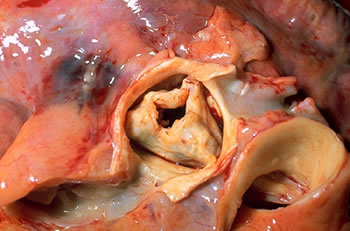Aortic Valve Stenosis
The aortic valve is a valve that separates the
left ventricle (the heart's pumping chamber) from the aorta or
the major artery that supplies blood to the body.
In aortic valve stenosis, calcium buildup in
the valve leaflets cause them to stiffen and fail to open completely.
When the heart beats, blood flowing out of the left ventricle
is impeded thus causing pressure to build up in the chamber. In
time, this can cause the thickening of the heart wall, as well
as enlargement and weakening of the heart.

Aortic valve stenosis: thickened and fused aortic valve leaflets.
In this condition, the aortic valve leaflets can also fail to
close completely - this causes blood to flow backward from the
aorta into the heart in a condition called aortic valve
regurgitation.
In a related condition called idiopathic hypertrophic
subaortic stenosis (IHSS), the muscle
beneath the aortic valve thickened. Although the valve remains
normal, because of the narrowed passage, blood flow is impeded.
Aortic Valve Stenosis Symptoms
The symptoms of aortic valve stenosis are:
- Shortness of breath
- Chest pain or discomfort
- Loss of conciousness or fainting, especially after strenuous
physical activity
These symptoms usually do not show until middle age, although
idiopathic hypertrophic subaortic stenosis (IHSS) can cause sudden
death in healthy young people.
Diagnosis
Your doctor would perform the following tests:
- Physical examination
A characteristic heart murmur (harsh murmur during heart contraction
and soft murmur in the relaxation) can be observed with a stethoscope.
Your doctor would also look for signs of weak pulse in the carotid
artery.
- Electrocardiogram or ECG
Aortic valve stenosis would show enlargement of the left heart
chamber and abnormal shape of the aortic valve.
- Cardiac catheterization
By injecting a dye into the heart through a catheter inserted
in the arm or leg, your doctor can visualize the abnormal shape
of the aortic valve.
Aortic Valve Stenosis Treatment
People who are diagnosed with heart valve abnormality should
always notify their doctor, surgeon, and dentist before any medical
procedure in order to get a precautionary dose of antibiotics.
This is because people with heart abnormality are predisposed
to getting bacterial infection of the heart or endocarditis.
Treatment for aortic valve stenosis include:
- Medications to strengthen heart beats
- Blood-thinning medications
- Heart valve surgery
Usually heart valve replacement is required once symptoms begin
to show.
Prognosis
When the symptoms begin, the prognosis without surgery is poor.
Although heart valve replacement surgery does carry a low risk
of dying (2 to 5% mortality rate), the patient's post-surgical
prognosis is much improved.


